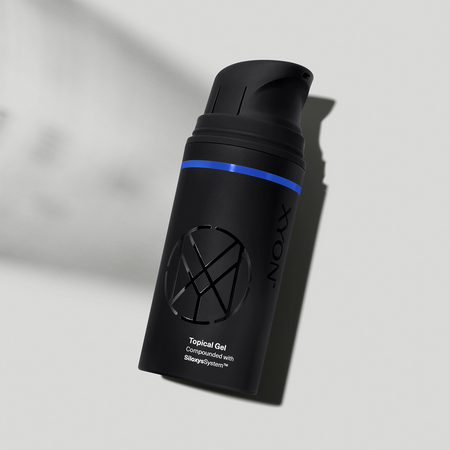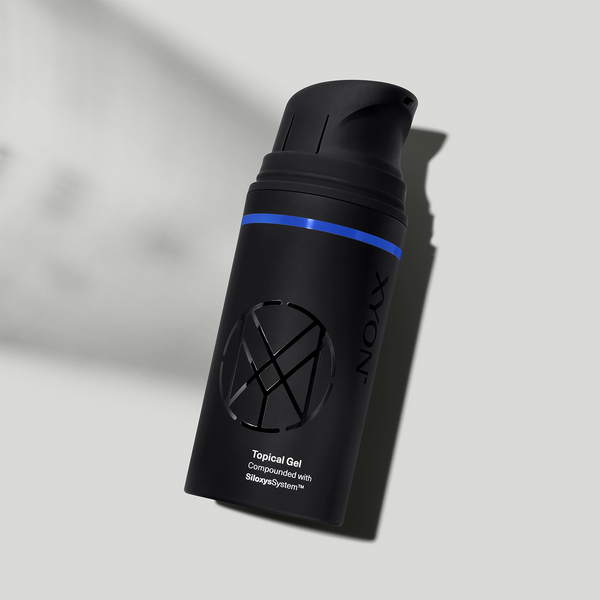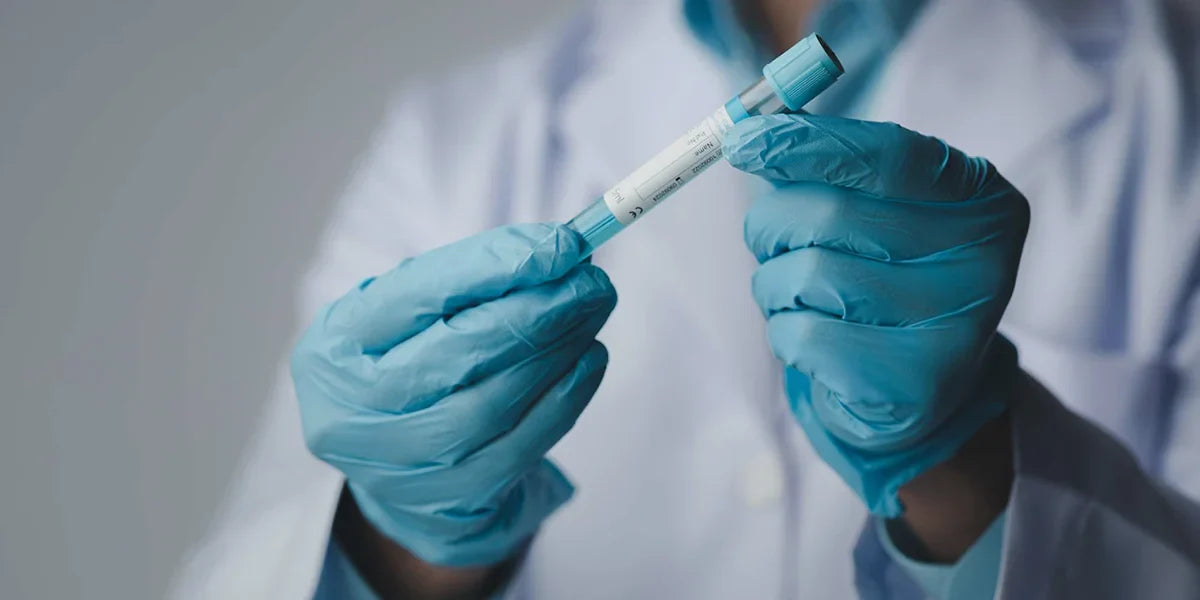SiloxysSystem™ Gel: New hair loss technology
SiloxysSystem™ Gel, a liposomal gel delivery system, was developed to allow healthcare professionals to administer clinically effective medications such as finasteride and dutasteride to the skin in a precise and highly targeted way. This novel delivery system has been designed to help minimize the risk of side effects associated with oral medications, without compromising efficacy.
A newer generation 5-alpha reductase inhibitor, dutasteride, has increasingly been prescribed off-label to treat androgenetic alopecia (pattern hair loss). The medication is a competitive inhibitor of two isoforms of the 5-alpha reductase enzyme, Type 1 and Type 2. The inhibition of this enzyme dramatically reduces levels of the androgen dihydrotestosterone (DHT), widely regarded as a primary trigger for pattern hair loss in male patients and potential trigger for female pattern hair loss. In particular, elevated scalp DHT concentrations have been documented in patients presenting for this genetically-driven and progressive hair loss disorder.
The concern for side effects is greater with oral dutasteride, as the route of administration inevitably leads to higher systemic exposure. It seems that this risk can be mitigated by opting for topical application. Changing the route of administration has been previously shown to be effective in improving the safety profile and tolerability of finasteride, while minimizing the impact on DHT levels (Piraccini et al., 2021).
Combat the effects of DHT on hair follicles with a state-of-the-art formula.


Topical Dutasteride with SiloxysSystem™ Gel treats hair loss with fewer side effects.
As such, we decided to explore the topical application of dutasteride, using SiloxysSystem™ Gel as the vehicle. The gel, composed of specially selected liposomes suspended in a silicone base, allows for the timed-release of dutasteride to maximize the distribution and uptake of the medication among hair follicle cells. The result is a reduction in the excess movement of drug molecules into the bloodstream and the potential for fewer side effects.
How was topical dutasteride tested?
The methods used to characterize the safety and efficacy of topical dutasteride are nearly identical to those performed as part of XYON’s previous clinical studies on SiloxysSystem™ Gel using finasteride. These included a Franz Cell Diffusion Test, as well as a pharmacokinetic study in human subjects.
Franz Cell - Skin Permeation Component (University of Milan)
- A 1% w/w topical liposomal formulation of dutasteride was prepared using SiloxysSystem™ Gel. The gel was introduced into the donor chamber of the Franz Cell apparatus, this time outfitted with a wider donor and receptor chamber and a pig ear sample acting as the membrane. This skin sample was prepared using standard methods.
- Epidermis was mounted onto the lower half of the Franz Cell apparatus and the test substance applied to the membrane on the donor side of the chamber.
- The receptor side of the chamber was filled with a saline solution. A water bath helped maintain a temperature of 37 degrees celsius. A stirrer bar was added to continuously agitate the solution.
- Over 24 hours, at timepoints 1, 3, 5, 7 and 24 hours, 0.2 mL samples were withdrawn from the receiver compartment for analysis. and replaced with some fresh receiver solution.
- Three replicates were performed per test preparation and withdrawn samples analyzed using liquid chromatography with tandem mass spectrometry (LC/MS-MS) to determine concentrations of dutasteride.
Franz Cell - Skin Retention Component
- To measure skin retention, epidermis samples were removed from the Franz Cell apparatus after 24 hours and carefully washed with 10 mL methanol to remove any residual test substance.
- The membranes were cut into small pieces which were then placed into tubes containing 5 mL methanol.
- The samples were sonicated for 30 mins and left to stand for 24 hours. After 24 h, the supernatant was centrifuged at 3000 rpm for 10 mins at 23 degrees celsius and analyzed using LC/MS-MS.
Results of Franz Cell Tests

Based on the conditions set by this experiment, very small amounts of dutasteride (lower than the lower limit of quantification of the LC/MS-MS assay) were found in the receiver chamber. Furthermore, examination of skin retention samples showed that approximately 1% of the administered dose of topical dutasteride was delivered to the skin. Although a single digit measurement, this number denotes appreciable permeation of dutasteride into the epidermis and a target tissue concentration well exceeding the potency benchmark (IC50) for dutasteride.
Human pharmacokinetic (PK) study
A PK study was performed in humans to assess the quantity of dutasteride that entered the systemic circulation, as well as the potential effects (if any) on serum levels of DHT following administration using SiloxysSystem™ Gel. Participants were considered eligible for the study if the following criteria were met:
- Clinical diagnosis of moderate-advanced androgenetic alopecia, assessed using the Hamilton-Norwood scale
- Not actively using dutasteride or no dutasteride use in the month preceding enrollment
- No anabolic steroid use, antiandrogen therapy or testosterone replacement in the 6 months preceding enrollment
- Healthy and intact scalp skin with no concomitant use of other topical treatments
- Not taking any other investigational products
- Willingness to abstain from sexual activity or exercise on the morning of any blood draws
Informed consent was obtained from each participant prior to beginning any study procedures. Participants were informed of possible risks and benefits associated with the study treatment and instructed to inform the principal investigator, Dr. Hasson, about any adverse effects. All study procedures were overseen by Dr. Hasson.
Method
- A pretreatment blood draw was performed to obtain baseline DHT measurements for each participant. Repeat this at hour 1 and hour 4 after the first blood draw to establish a control.
- After the final pre-treatment blood draw, once daily dosing with 2% w/w Topical Dutasteride, with SiloxysSystem™ was commenced. Treatment was continued for 1 month to allow dutasteride levels to reach 65-70% of steady state*.
- After 1 month, participants returned to the clinic in the morning for a series of blood draws. Participants were instructed to not take their usual dose at home. One pretreatment draw was performed to obtain a trough value. Participants were then administered Topical Dutasteride, with SiloxysSystem™ and subsequent draws were performed at hours 1, 2, 4, 8 and 24 post-dose.
Steady state is reached when the amount of a medication being eliminated from the body matches the quantity of medication entering the body. Typically, this is the point at which the mediation takes maximum effect.
PK Test Results



Dutasteride’s effects on serum DHT levels were also minimized when delivered using our proprietary topical vehicle. Figure 2 describes a mean percentage change in DHT levels of -19 ± 21% using SiloxysSystem™ Gel. For comparison, the reference DHT change for oral dutasteride is -93 ± 23%.
Discussion of topical dutasteride clinical trial results
The results of both the Franz Cell and PK tests provide further support for SiloxysSystem™ Gel, a novel topical delivery system designed to help reduce systemic exposure to active pharmaceutical ingredients and by extension, the risk of side effects commonly associated with oral hair loss medications. Skin permeation and retention data show a 17-18x decrease in serum dutasteride levels and a retention % of approximately 1% (Table 1). Taken together, this data suggests that the gel vehicle prevents appreciable absorption of active ingredients while successfully delivering drugs to their intended target tissue.
The gel’s precision delivery is further corroborated by human PK data, which demonstrate a very modest suppression of DHT levels (Table 2). Given dutasteride’s higher potency, it is desirable to control the extent to which DHT suppression occurs. In Figure 2, we note a small positive increase in serum DHT levels with topical dutasteride. Out of the ten study participants, two experienced increases in DHT over the course of their involvement in the trial. It is unclear what was responsible for these increases, but these data points were included in the final analysis.
In general, 5-alpha reductase inhibitors such as dutasteride are well-tolerated. Available safety data focus on the oral form of the medication, which has been linked to a small, but elevated incidence of side effects such as sexual dysfunction, decreased libido and in some cases, depression. We propose topical delivery of dutasteride using SiloxysSystem™ Gel as a solution for people at risk for, experiencing or concerned about dutasteride side effects. The vehicle’s unique composition and barrier-forming properties allow for targeted and consistent delivery of hair loss medications directly to affected areas of the scalp, while minimizing broad effects on DHT.
Acknowledgements
We would like to thank our study participants and the clinic staff at the office of Dr. Hasson for their commitment to this project. We would also like to thank Dr. Hasson for his clinical oversight and guidance throughout the study.
We also wish to extend our appreciation to Dr. Antonella Casiraghi (Università degli Studi di Milano) and colleagues for their work on the Franz Cell skin permeation and retention studies and Dr. Jay Cadieux for the preparation and interpretation of this data.




